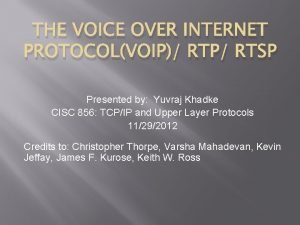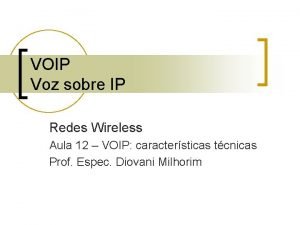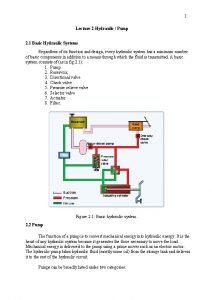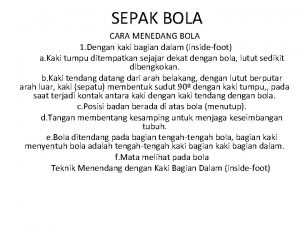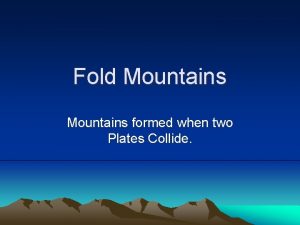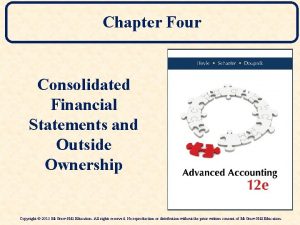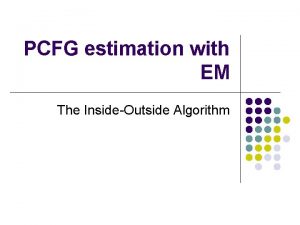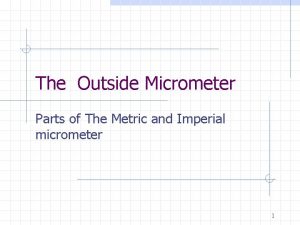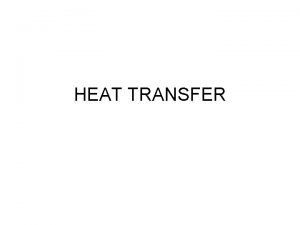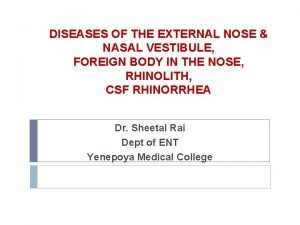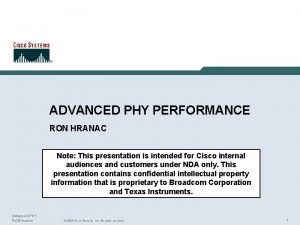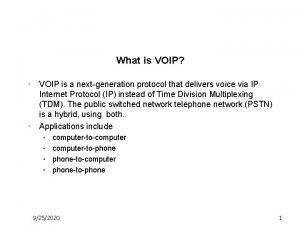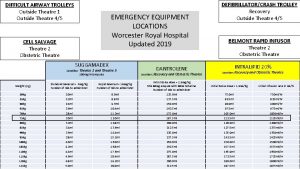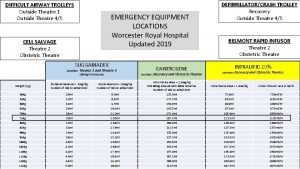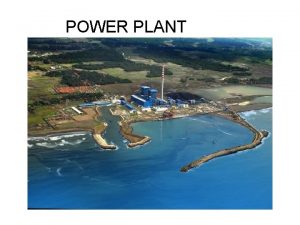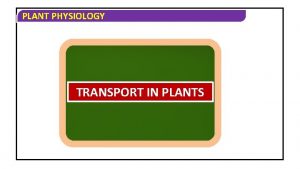DEPLOYING VOIP ON THE OUTSIDE PLANT RON HRANAC
































































































- Slides: 96

DEPLOYING VOIP ON THE OUTSIDE PLANT RON HRANAC rhranacj@cisco. com Deploying Vo. IP on the Outside Plant © 2004 Cisco Systems, Inc. All rights reserved. 1

Vo. IP—Voice Over Internet Protocol A much-too-common myth: “High-speed data works fine in my system, so voice should be no problem!” Deploying Vo. IP on the Outside Plant © 2004 Cisco Systems, Inc. All rights reserved. 2

Vo. IP—The Philosophy Vo. IP requires an organizational change: It’s not your father’s high-speed data! Deploying Vo. IP on the Outside Plant © 2004 Cisco Systems, Inc. All rights reserved. 3

Vo. IP—The Reality • High-speed data and voice services can in most cases be successfully deployed on a CATV network if the ENTIRE cable system—headend, distribution network, and subscriber drops—meets or exceeds certain minimum technical performance parameters. Deploying Vo. IP on the Outside Plant © 2004 Cisco Systems, Inc. All rights reserved. 4

Recommended Network Specifications • The first is the technical requirements in Part 76 of the FCC Rules http: //www. ecfr. gov/cgi-bin/textidx? c=ecfr&sid=3100 d 6 c 36 aa 8 d 24 cb 14 d 0 de 0 e 94 df 597&tpl= /ecfrbrowse/Title 47/47 cfr 76_main_02. tpl • The second is the assumed RF channel transmission characteristics outlined in the DOCSIS® 1. 1 (or later) specification http: //www. cablelabs. com/specifications/ • The third is ensuring the HFC plant’s unavailability contribution does not exceed 0. 01% as described in the Packet. Cable™ Availability Reference Architecture http: //www. cablelabs. com/specifications/ Deploying Vo. IP on the Outside Plant © 2004 Cisco Systems, Inc. All rights reserved. 5

FCC Rules Deploying Vo. IP on the Outside Plant © © 2004, 2004 Cisco Systems, Inc. All rights reserved. 66

FCC Rules: Part 76 • Minimum visual carrier amplitude: 0 d. Bm. V at the subscriber terminal; +3 d. Bm. V at the end of a 30 meter drop. • Maximum visual carrier amplitude: Do not overload the subscriber’s receiver or terminal • Aural carrier amplitude: 10 d. B to 17 d. B below the visual carrier • Visual carrier amplitude change: No more than 8 d. B variation on any channel within any six month interval No more than 3 d. B variation during a 24 -hour period between any adjacent visual carriers within the cable system bandwidth No more than 10 d. B difference between any two channels in 300 MHz systems, +1 d. B for each additional 100 MHz bandwidth Deploying Vo. IP on the Outside Plant © 2004 Cisco Systems, Inc. All rights reserved. 7

FCC Rules: Part 76 • Aural carrier frequency: No more than +/- 5 k. Hz from nominal frequency (i. e. , for NTSC channels, the aural carrier must be 4. 5 MHz +/- 5 k. Hz above the visual carrier) • In-channel frequency response: +/- 2 d. B (for 6 MHz NTSC channels this specification must be met from 0. 75 MHz to 5. 0 MHz above the lower frequency boundary of the channel) • Visual carrier-to-noise ratio: 43 d. B (relative to a 4 MHz noise bandwidth for NTSC television channels) • Visual carrier-to-coherent disturbance ratio (CTB, CSO, XMOD) 51 d. B for standard and IRC channelization; 47 d. B for HRC channelization • Terminal isolation: Minimum 18 d. B, and sufficient to prevent reflections caused by open- or short-circuited subscriber terminals from producing visible picture impairments at any other subscriber terminal Deploying Vo. IP on the Outside Plant © 2004 Cisco Systems, Inc. All rights reserved. 8

FCC Rules: Part 76 • Low frequency disturbances (hum): The peak-to-peak variation in visual signal level caused by undesired low-frequency disturbances is not to exceed 3% of the visual signal level • Chrominance-to-luminance delay inequality: 170 nanoseconds or less • Differential gain: Maximum +/-20% • Differential phase: Maximum +/-10 degrees • Signal leakage (less than and including 54 MHz and greater than 216 MHz): No more than 15 µV/m field strength at a 30 meter measurement distance using a resonant half-wave dipole • Signal leakage (over 54 MHz up to and including 216 MHz): No more than 20 µV/m field strength at a three meter measurement distance using a resonant half-wave dipole Deploying Vo. IP on the Outside Plant © 2004 Cisco Systems, Inc. All rights reserved. 9

DOCSIS® Radio Frequency Interface Specification Deploying Vo. IP on the Outside Plant © © 2004, 2004 Cisco Systems, Inc. All rights reserved. 10 10

DOCSIS® 1. 1 Assumed Downstream RF Channel Transmission Characteristics Deploying Vo. IP on the Outside Plant © 2004 Cisco Systems, Inc. All rights reserved. 11

RF Channel Spacing (Design Bandwidth) 6 MHz Deploying Vo. IP on the Outside Plant © 2004 Cisco Systems, Inc. All rights reserved. 12

RF Channel Spacing (Design Bandwidth) Deploying Vo. IP on the Outside Plant © 2004 Cisco Systems, Inc. All rights reserved. 13

Transit Delay <=0. 800 msec Deploying Vo. IP on the Outside Plant © 2004 Cisco Systems, Inc. All rights reserved. 14

Transit Delay • Signals traveling one way from the headend to the subscriber through, say, 18 km of fiber and 1 km of coax: about 95 microseconds (μsec) transit delay • The DOCSIS transit delay specification is <0. 800 millisecond (msec) one way Coax serving area Headend Fiber Node 18 km Deploying Vo. IP on the Outside Plant © 2004 Cisco Systems, Inc. All rights reserved. 1 km ~95 μsec 15

Carrier-to-Noise Ratio Not less than 35 d. B Deploying Vo. IP on the Outside Plant © 2004 Cisco Systems, Inc. All rights reserved. 16

Carrier-to-Noise Ratio Courtesy of Agilent Technologies and Sunrise Telecom Deploying Vo. IP on the Outside Plant © 2004 Cisco Systems, Inc. All rights reserved. 17

Digitally Modulated Signal CNR vs. BER Modulation format Deploying Vo. IP on the Outside Plant 1. 0 E-04 1. 0 E-06 1. 0 E-08 1. 0 E-10 1. 0 E-12 ASK & FSK 7 d. B 9 d. B 10 d. B 11 d. B 12 d. B BPSK 9 d. B 11 d. B 12 d. B 13 d. B 14 d. B QPSK 12 d. B 14 d. B 15 d. B 16 d. B 17 d. B 16 -QAM 19 d. B 21 d. B 22 d. B 23 d. B 24 d. B 32 -QAM 21 d. B 23 d. B 24 d. B 25 d. B 26 d. B 64 -QAM 25 d. B 27 d. B 28 d. B 29 d. B 30 d. B 256 -QAM 32 d. B 34 d. B 35 d. B 36 d. B 37 d. B © 2004 Cisco Systems, Inc. All rights reserved. 18

Digitally Modulated Signal CNR vs. BER 256 -QAM requires 6 d. B better CNR to achieve the same bit error ratio as 64 -QAM!!! Many cable operators transmit 64 -QAM digitally modulated signals at -10 d. Bc relative to analog TV channels, and increase the amplitude of 256 -QAM digitally modulated signals to -5 to -6 d. Bc. Deploying Vo. IP on the Outside Plant © 2004 Cisco Systems, Inc. All rights reserved. 19

Carrier-to-Distortion or Interference Ratio Not less than 41 d. B Deploying Vo. IP on the Outside Plant © 2004 Cisco Systems, Inc. All rights reserved. 20

Carrier-to-Distortion or Interference Ratio This example shows an inchannel carrierto-interference ratio of 48. 3 d. B about 0. 5 MHz above center frequency CSO CTB QAM signal’s suppressed carrier Intermodulation Graphic courtesy of JDSU (Acterna) Deploying Vo. IP on the Outside Plant © 2004 Cisco Systems, Inc. All rights reserved. 21

Amplitude Ripple 3. 0 d. B within the design bandwidth Deploying Vo. IP on the Outside Plant © 2004 Cisco Systems, Inc. All rights reserved. 22

Amplitude Ripple Courtesy of Agilent Technologies and Sunrise Telecom Deploying Vo. IP on the Outside Plant © 2004 Cisco Systems, Inc. All rights reserved. 23

Amplitude Ripple This example shows less than 1 d. B peak-topeak amplitude ripple (inchannel frequency response flatness) Courtesy of Sunrise Telecom Deploying Vo. IP on the Outside Plant © 2004 Cisco Systems, Inc. All rights reserved. 24

Group Delay 75 ns within the design bandwidth Deploying Vo. IP on the Outside Plant © 2004 Cisco Systems, Inc. All rights reserved. 25

Group Delay This example shows about 40 nanoseconds of in-channel group delay ripple Courtesy of Sunrise Telecom Deploying Vo. IP on the Outside Plant © 2004 Cisco Systems, Inc. All rights reserved. 26

Micro-reflections -10 d. Bc @ <= 0. 5 µsec -15 d. Bc @ <= 1. 0 µsec -20 d. Bc @ <=1. 5 µsec -30 d. Bc @ > 1. 5 µsec Deploying Vo. IP on the Outside Plant © 2004 Cisco Systems, Inc. All rights reserved. 27

Micro-reflections • Micro-reflections—also called reflections or echoes— are caused by impedance mismatches • In the real world of cable networks, impedance can at best be considered nominal • Impedance mismatches are everywhere: connectors, amplifiers inputs and outputs, passive device inputs and outputs, and even the cable itself • Upstream cable attenuation is lower than downstream cable attenuation, so upstream Microreflections tend to be worse • Anywhere an impedance mismatch exists, some of the incident energy is reflected back toward the source Deploying Vo. IP on the Outside Plant © 2004 Cisco Systems, Inc. All rights reserved. 28

Micro-reflections • The reflected and incident energy interact to produce standing waves, which manifest themselves as the “standing wave” amplitude ripple one sometimes sees in sweep receiver displays • Higher orders of modulation are affected by microreflections to a much greater degree (e. g. , 256 -QAM vs 64 QAM, 16 -QAM vs QPSK) • Downstream micro-reflections and group delay may be compensated for using adaptive equalization, a feature available in all DOCSIS modems • Upstream micro-reflections and group delay may be compensated for using adaptive equalization, a feature available in DOCSIS 1. 1 and 2. 0 cable modems Upstream adaptive equalization is not supported by most DOCSIS 1. 0 modems Deploying Vo. IP on the Outside Plant © 2004 Cisco Systems, Inc. All rights reserved. 29

Micro-reflections Causes: • Damaged or missing end-of-line terminators • Damaged or missing chassis terminators on directional coupler, splitter, or multiple-output amplifier unused ports • Loose center conductor seizure screws • Unused tap ports not terminated—this is especially critical on low value taps • Unused drop passive ports not terminated • Use of so-called self-terminating taps at feeder endsof-line Deploying Vo. IP on the Outside Plant © 2004 Cisco Systems, Inc. All rights reserved. 30

Micro-reflections Causes (cont’d): • Kinked or damaged cable (includes cracked cable, which causes a reflection and ingress) • Defective or damaged actives or passives (waterdamaged, water-filled, cold solder joint, corrosion, loose circuit board screws, etc. ) • Cable-ready TVs and VCRs connected directly to the drop (return loss on most cable-ready devices is poor) • Some traps and filters have been found to have poor return loss in the upstream, especially those used for data-only service Deploying Vo. IP on the Outside Plant © 2004 Cisco Systems, Inc. All rights reserved. 31

Micro-reflections • Here’s an approx. -40 d. Bc echo at just over 2 µsec • This echo easily meets the DOCSIS downstream -30 d. Bc @ >1. 5 µsec parameter • Amplitude ripple is negligible, and group delay ripple is slight Courtesy of Sunrise Telecom Deploying Vo. IP on the Outside Plant © 2004 Cisco Systems, Inc. All rights reserved. 32

DOCSIS® 1. 1 Assumed Upstream RF Channel Transmission Characteristics Deploying Vo. IP on the Outside Plant © 2004 Cisco Systems, Inc. All rights reserved. 33

Transit Delay <=0. 800 msec Deploying Vo. IP on the Outside Plant © 2004 Cisco Systems, Inc. All rights reserved. 34

Transit Delay • Signals traveling one way from the subscriber to the headend through, say, 1 km of coax and 18 km of fiber: about 95 microseconds (μsec) transit delay • The DOCSIS transit delay specification is <0. 800 millisecond (msec) one way Coax serving area Headend Fiber Node 18 km Deploying Vo. IP on the Outside Plant © 2004 Cisco Systems, Inc. All rights reserved. 1 km ~95 μsec 35

Upstream RF Channel Characteristics Not less than 25 d. B Deploying Vo. IP on the Outside Plant © 2004 Cisco Systems, Inc. All rights reserved. 36

Upstream Digitally Modulated Signal Amplitude • • Because of the bursty nature of upstream digitally modulated carriers, it’s difficult to measure average power level Deploying Vo. IP on the Outside Plant © 2004 Cisco Systems, Inc. All rights reserved. The zero-span method is the easiest way to obtain an accurate amplitude measurement 37

Upstream Carrier-to-Interference Deploying Vo. IP on the Outside Plant © 2004 Cisco Systems, Inc. All rights reserved. 38

Amplitude Ripple 0. 5 d. B/MHz Deploying Vo. IP on the Outside Plant © 2004 Cisco Systems, Inc. All rights reserved. 39

Amplitude Ripple • In this example, an approx. -23 d. Bc echo at ~720 ns causes visible amplitude ripple across the 5 -40 MHz spectrum • Group delay ripple also is present Echo Amplitude ripple Group delay ripple Courtesy of Holtzman, Inc. Deploying Vo. IP on the Outside Plant © 2004 Cisco Systems, Inc. All rights reserved. 40

Group Delay 200 ns/MHz Deploying Vo. IP on the Outside Plant © 2004 Cisco Systems, Inc. All rights reserved. 41

Group Delay • QPSK typically requires a minimum MER of 10~13 d. B, depending on CMTS make/model • 16 -QAM typically requires a minimum MER of 17~20 d. B, depending on CMTS make/model DOCSIS 200 ns/MHZ 16 -QAM QPSK Courtesy of Holtzman, Inc. Deploying Vo. IP on the Outside Plant © 2004 Cisco Systems, Inc. All rights reserved. 42

Group Delay • Upstream group delay measurements require specialized equipment • In this example, group delay is nearly constant (within about 100 ns) between 10 and 35 MHz Courtesy of Holtzman, Inc. Deploying Vo. IP on the Outside Plant © 2004 Cisco Systems, Inc. All rights reserved. 43

Group Delay • Specialized test equipment can be used to characterize upstream inchannel performance • In this example, inchannel group delay ripple is about 60 ns Courtesy of Sunrise Telecom Deploying Vo. IP on the Outside Plant © 2004 Cisco Systems, Inc. All rights reserved. 44

Micro-reflections -10 d. Bc @ <=0. 5 µsec -20 d. Bc @ <=1. 0 µsec -30 d. Bc @ >1. 0 µsec Deploying Vo. IP on the Outside Plant © 2004 Cisco Systems, Inc. All rights reserved. 45

Micro-reflections • In this example, an approx. -23 d. Bc echo is visible at ~720 ns (0. 720 µsec) • This echo meets the DOCSIS upstream -20 d. Bc at <=1. 0 µsec parameter • Note that the echo is still sufficient to cause amplitude and group delay ripple Deploying Vo. IP on the Outside Plant © 2004 Cisco Systems, Inc. All rights reserved. Echo Amplitude ripple Group delay ripple 46

Micro-reflections • Here’s another example: An approx. -33 d. Bc echo at just over 1 µsec • This echo meets the DOCSIS upstream -30 d. Bc at >1. 0 µsec parameter • Here, too, the echo is sufficient to cause some amplitude and group delay ripple Deploying Vo. IP on the Outside Plant © 2004 Cisco Systems, Inc. All rights reserved. 47

Micro-reflections • Here’s yet another example: An approx. -22 d. Bc echo at about 2. 5 µsec • This echo does not meet the DOCSIS upstream -30 d. Bc at >1. 0 µsec parameter • In-channel amplitude ripple is 1. 6 d. B, and group delay ripple is about 270 ns 16 -QAM would not work on this upstream! Deploying Vo. IP on the Outside Plant © 2004 Cisco Systems, Inc. All rights reserved. 48

DOCSIS® 1. 1 Electrical Input to the Cable Modem Deploying Vo. IP on the Outside Plant © 2004 Cisco Systems, Inc. All rights reserved. 49

Downstream Digitally Modulated Signal Amplitude -15 to +15 d. Bm. V Deploying Vo. IP on the Outside Plant © 2004 Cisco Systems, Inc. All rights reserved. 50

Downstream Digitally Modulated Signal Amplitude • When measuring the amplitude of a digitally modulated signal, make certain you are measuring its average power level • Use test equipment that performs automated measurements, rather than trying to make error-prone manual measurements that require bandwidth, IF filter, log amplifier and detector corrections • A “sweet spot” for downstream digitally modulated signal amplitude at the modem or e. MTA input is -10 to +5 d. Bm. V Courtesy Agilent Technologies and Sunrise Telecom Deploying Vo. IP on the Outside Plant © 2004 Cisco Systems, Inc. All rights reserved. 51

Cable Modem Total Input Power < +30 d. Bm. V Deploying Vo. IP on the Outside Plant © 2004 Cisco Systems, Inc. All rights reserved. 52

Cable Modem Total Input Power This example shows total input power is +15 d. Bm. V Courtesy of Agilent Technologies Deploying Vo. IP on the Outside Plant © 2004 Cisco Systems, Inc. All rights reserved. 53

Cable Modem Total Input Power • A quick way to estimate approximate total power is based on the rule-of-thumb that each time the number of channels doubles (assuming all channels have the same signal level), the total power increases 3 d. B (3. 01 d. B). Deploying Vo. IP on the Outside Plant Number of Channels Power per Channel Total Power 1 0 d. Bm. V 2 0 d. Bm. V +3 d. Bm. V 4 0 d. Bm. V +6 d. Bm. V 8 0 d. Bm. V +9 d. Bm. V 16 0 d. Bm. V +12 d. Bm. V 32 0 d. Bm. V +15 d. Bm. V 64 0 d. Bm. V +18 d. Bm. V 128 0 d. Bm. V +21 d. Bm. V © 2004 Cisco Systems, Inc. All rights reserved. 54

Other DOCSIS® RFI Spec Parameters • Downstream digitally modulated signal average power level relative to analog visual carrier levels: -10 d. Bc to -6 d. Bc • 64 -QAM bit error ratio: Cable modem post-FEC BER must be less than or equal to 10 -8 when operating at a C/N ratio (ES/N 0) of 23. 5 d. B or greater • 256 -QAM bit error ratio: CM post-FEC BER must be less than or equal to 10 -8 when operating at a C/N ratio (ES/N 0) of 30 d. B or greater when the input receive signal level is -6 d. Bm. V to +15 d. Bm. V 33 d. B or greater when the input receive signal level is -6 d. Bm. V down to -15 d. Bm. V Deploying Vo. IP on the Outside Plant © 2004 Cisco Systems, Inc. All rights reserved. 55

Downstream Performance: QAM Analyzer Pre- and post. FEC BER MER 64 -QAM: 27 d. B minimum 256 -QAM: 31 d. B minimum Constellation Graphic courtesy of Sunrise Telecom Deploying Vo. IP on the Outside Plant © 2004 Cisco Systems, Inc. All rights reserved. 56

Downstream Performance: QAM Analyzer Equalizer graph In-channel frequency response In-channel group delay Digital channel power Graphic courtesy of Sunrise Telecom Deploying Vo. IP on the Outside Plant © 2004 Cisco Systems, Inc. All rights reserved. 57

Downstream Performance: QAM Analyzer Poor carrier-to-noise ratio Phase noise I-Q imbalance Gain compression Deploying Vo. IP on the Outside Plant Coherent interference © 2004 Cisco Systems, Inc. All rights reserved. Zoom function 58

Headend RF Levels—Integrated Upconverter • Verify correct average power level Integrated upconverter RF output should be set in the DOCSIS-specified +50 to +61 d. Bm. V range Typical levels are +55 to +58 d. Bm. V • Also check BER, MER and constellation Deploying Vo. IP on the Outside Plant © 2004 Cisco Systems, Inc. All rights reserved. 59

Headend RF Levels—External Upconverter • Verify correct average power level, BER, MER and constellation CMTS downstream IF output External upconverter IF input External upconverter RF output Deploying Vo. IP on the Outside Plant © 2004 Cisco Systems, Inc. All rights reserved. 60

Downstream Performance: QAM Analyzer • Check signal levels and BER at downstream laser input and node output Bit errors at downstream laser input but not at CMTS or upconverter output may indicate sweep transmitter interference, loose connections or combiner problems Bit errors at node output but not at laser input are most likely caused by downstream laser clipping Deploying Vo. IP on the Outside Plant © 2004 Cisco Systems, Inc. All rights reserved. 61

Headend RF Levels • DOCSIS recommends that the digitally modulated carrier’s average power level be set 6 d. B to 10 d. B below what the visual carrier level of an analog TV channel on the same frequency would be • This ratio should be maintained throughout the entire cable network Deploying Vo. IP on the Outside Plant © 2004 Cisco Systems, Inc. All rights reserved. 62

Analog TV Channel Amplitude Measurement Courtesy Agilent Technologies and Sunrise Telecom Deploying Vo. IP on the Outside Plant © 2004 Cisco Systems, Inc. All rights reserved. 63

Downstream Digitally Modulated Signal Amplitude Measurement Courtesy Agilent Technologies and Sunrise Telecom Deploying Vo. IP on the Outside Plant © 2004 Cisco Systems, Inc. All rights reserved. 64

Downstream Digitally Modulated Signal Amplitude Measurement Courtesy Communications Technology Magazine Deploying Vo. IP on the Outside Plant © 2004 Cisco Systems, Inc. All rights reserved. 65

Downstream Digitally Modulated Signal Amplitude Measurement Courtesy Communications Technology Magazine Deploying Vo. IP on the Outside Plant © 2004 Cisco Systems, Inc. All rights reserved. 66

Downstream Digitally Modulated Signal Amplitude Measurement Courtesy Communications Technology Magazine Deploying Vo. IP on the Outside Plant © 2004 Cisco Systems, Inc. All rights reserved. 67

Downstream Digitally Modulated Signal Amplitude Measurement Courtesy Communications Technology Magazine Deploying Vo. IP on the Outside Plant © 2004 Cisco Systems, Inc. All rights reserved. 68

Downstream Digitally Modulated Signal Amplitude Measurement Courtesy Communications Technology Magazine Deploying Vo. IP on the Outside Plant © 2004 Cisco Systems, Inc. All rights reserved. 69

Downstream Digitally Modulated Signal Amplitude Measurement Courtesy Communications Technology Magazine Deploying Vo. IP on the Outside Plant © 2004 Cisco Systems, Inc. All rights reserved. 70

Upstream Performance: Constellations and MER Good QPSK and 16 -QAM constellations Graphics courtesy of Filtronic Sigtek, Inc. Deploying Vo. IP on the Outside Plant © 2004 Cisco Systems, Inc. All rights reserved. 71

Upstream Performance: Constellations and MER Poor carrier-to-noise ratio, low MER Graphics courtesy of Filtronic Sigtek, Inc. Deploying Vo. IP on the Outside Plant © 2004 Cisco Systems, Inc. All rights reserved. 72

Other Challenges • Dealing with the slightly lower dynamic range of 16 QAM modem transmission compared to QPSK DOCSIS 1. 1 specifies that cable modems must support +8 to +58 d. Bm. V upstream transmission levels for QPSK, and +8 to +55 d. Bm. V for 16 -QAM (these levels are different in later versions of DOCSIS) • A switch to 16 -QAM loses 3 d. B of headroom If some modems are transmitting at their maximum level with QPSK, they may exhibit problems when switched to 16 -QAM • Typical fix is to correct excessive upstream attenuation between the affected modem and the first upstream active Usually drop- or network alignment-related Deploying Vo. IP on the Outside Plant © 2004 Cisco Systems, Inc. All rights reserved. 73

Upstream Performance: Packet Loss Some QAM analyzers support upstream packet loss measurements Graphics courtesy of Acterna, Sunrise Telecom and Trilithic Deploying Vo. IP on the Outside Plant © 2004 Cisco Systems, Inc. All rights reserved. 74

Packet. Cable™ Availability Reference Model Deploying Vo. IP on the Outside Plant © © 2004, 2004 Cisco Systems, Inc. All rights reserved. 75 75

First, Some Definitions • Availability: The ratio of time that a service is available for use to total time. Packet. Cable’s reference model assumes 99. 94% end-to-end availability. The HFC network maximum contribution to this is 0. 01% unavailability, or 99. 99% availability—the so-called four nines. • Reliability: Probability that a system or device will not fail during some specified period. Deploying Vo. IP on the Outside Plant © 2004 Cisco Systems, Inc. All rights reserved. 76

Packet. Cable™ Availability Reference Model Source: Vo. IP Availability and Reliability Model for the Packet. Cable™ Architecture (PKT-TR-Vo. IPAR-V 01 -001128) Deploying Vo. IP on the Outside Plant © 2004 Cisco Systems, Inc. All rights reserved. 77

Contributors to Network Availability • Network architecture • System powering • Redundancy • Status monitoring • System maintenance practices • Subscriber drop installation quality • Service restoration Deploying Vo. IP on the Outside Plant © 2004 Cisco Systems, Inc. All rights reserved. 78

Relative Network Contributors to Outages Drop Headend Power Headend Trunk Power Feeder Trunk Feeder Relative network section contributions to outage rate Relative network section contributions to outage hours Source: Modern Cable Television Technology, 2 nd Ed. ; Ciciora, Farmer, Large, Adams; © 2004, Morgan Kaufmann Publishers Deploying Vo. IP on the Outside Plant © 2004 Cisco Systems, Inc. All rights reserved. 79

Network Availability Can a cable network meet 99. 99%? • According to an analysis in Modern Cable Television Technology, 2 nd Ed. , achieving 99. 99% availability requires: Improved HDT and NID reliability Hardened and more reliable powering Shorter cascades of both coaxial equipment and power supplies Reliable status monitoring throughout the network • Proactive maintenance • High quality drop installations Source: Modern Cable Television Technology, 2 nd Ed. ; Ciciora, Farmer, Large, Adams; © 2004, Morgan Kaufmann Publishers Deploying Vo. IP on the Outside Plant © 2004 Cisco Systems, Inc. All rights reserved. 80

Network Impairments That Affect Service Availability • Ingress and impulse noise • Improper network alignment • Distortions (CPD, hum, CSO, CTB) • Poor in-channel frequency response (amplitude tilt and ripple) • Group delay • Micro-reflections • Intermittent connections • Sweep transmitter interference • Laser clipping—upstream and downstream Deploying Vo. IP on the Outside Plant © 2004 Cisco Systems, Inc. All rights reserved. 81

Downstream Checklist ü Entire cable network—headend, distribution network and subscriber drops—DOCSIS-compliant ü Upconverter setup, IF input/RF output levels ü Downstream laser input levels ü Avoid downstream frequencies near band edges or rolloff areas ü Avoid downstream frequencies that may be susceptible to ingress from strong over-the-air signals 1 ü Forward and reverse properly aligned ü Frequency response flat ü Signal leakage and ingress management ü Good installation practices Deploying Vo. IP on the Outside Plant © 2004 Cisco Systems, Inc. All rights reserved. 82

Upstream Checklist ü CMTS modulation profile optimized for modulation format in use—for instance, 16 -QAM ü Entire cable network—headend, distribution network and subscriber drops—DOCSIS-compliant ü Select upstream frequency that avoids diplex filter roll-off area ü Forward and reverse properly aligned ü Signal leakage and ingress management ü Good installation practices Deploying Vo. IP on the Outside Plant © 2004 Cisco Systems, Inc. All rights reserved. 83

DOCSIS Checklist Headend (downstream) CMTS or upconverter output Test performed Parameter value Measured value/comments CMTS downstream IF output +42 d. Bm. V 1 Digitally modulated carrier amplitude at upconverter input +25 to +35 d. Bm. V 2 Digitally modulated carrier amplitude at upconverter output +50 to +61 d. Bm. V Digitally modulated carrier center frequency 91 -857 MHz Carrier-to-noise ratio Not less than 35 d. B Modulation error ratio (MER)3 64 -QAM: 27 d. B minimum 256 -QAM: 31 d. B minimum Deploying Vo. IP on the Outside Plant Pre-FEC BER 4 N/A Post FEC BER 5 Less than or equal to 10 -8 Amplitude ripple (in-channel flatness) 3 d. B 6 Group delay ripple 75 ns maximum Constellation evaluation Look for evidence of gain compression; phase noise; I-Q imbalance; coherent interference; excessive noise; and clipping © 2004 Cisco Systems, Inc. All rights reserved. 84

DOCSIS Checklist Headend (downstream) laser transmitter or first amplifier input, node output Test performed Parameter value Measured value/comments Digitally modulated carrier average power level relative to analog TV channel visual carrier amplitude -10 to -6 d. Bc Digitally modulated carrier center frequency 91 -857 MHz Carrier-to-noise ratio Not less than 35 d. B Modulation error ratio (MER)1 64 -QAM: 27 d. B minimum 256 -QAM: 31 d. B minimum Deploying Vo. IP on the Outside Plant Pre-FEC BER 2 N/A Post FEC BER 3 Less than or equal to 10 -8 Amplitude ripple (in-channel flatness) 3 d. B 4 Group delay ripple 75 ns maximum Constellation evaluation Look for evidence of gain compression; phase noise; I-Q imbalance; coherent interference; excessive noise; and clipping © 2004 Cisco Systems, Inc. All rights reserved. 85

DOCSIS Checklist Downstream input to cable modem Test performed Parameter value Measured value/comments Digitally modulated carrier center frequency 91 -857 MHz Digitally modulated carrier average power level relative to analog TV channel visual carrier amplitude -10 to -6 d. Bc Digitally modulated carrier average power level 1 -15 to +15 d. Bm. V Carrier-to-noise ratio Not less than 35 d. B Total downstream RF input power 2 <+30 d. Bm. V Modulation error ratio (MER)3 64 -QAM: 27 d. B minimum 256 -QAM: 31 d. B minimum Deploying Vo. IP on the Outside Plant Pre-FEC BER 4 N/A Post FEC BER Less than or equal to 10 -8 © 2004 Cisco Systems, Inc. All rights reserved. 86

DOCSIS Checklist Downstream input to cable modem (cont’d) Test performed Parameter value Measured value/comments Deploying Vo. IP on the Outside Plant Constellation evaluation Look for evidence of gain compression; phase noise; I-Q imbalance; coherent interference; excessive noise; and clipping Amplitude ripple (in-channel flatness) 3 d. B 4 Hum modulation 5% (-26 d. Bc) Maximum analog TV channel visual carrier level +17 d. Bm. V Minimum analog TV channel visual carrier level -5 d. Bm. V Transit delay from CMTS to most distant cable modem 5 <=0. 800 millisecond Signal level slope, 50 -750 MHz 16 d. B Group delay ripple 6 75 ns © 2004 Cisco Systems, Inc. All rights reserved. 87

DOCSIS Checklist CMTS upstream input Test performed Parameter value Measured value/comments Deploying Vo. IP on the Outside Plant Digitally modulated carrier bandwidth 200, 400, 800, 1, 600 or 3, 200 k. Hz Digitally modulated carrier symbol rate 160, 320, 640, 1, 280 or 2, 560 ksym/sec Digitally modulated carrier center frequency Must be within 5 -42 MHz spectrum Digitally modulated carrier amplitude 1 -16 to +26 d. Bm. V depending on symbol rate Total 5 -42 MHz RF spectrum power Must not exceed +35 d. Bm. V Carrier-to-noise ratio Not less than 25 d. B 2 Carrier-to-interference ratio Not less than 25 d. B 2 Carrier-to-ingress power ratio Not less than 25 d. B 2 © 2004 Cisco Systems, Inc. All rights reserved. 88

DOCSIS Checklist CMTS upstream input (cont’d) Test performed Parameter value Measured value/comments Deploying Vo. IP on the Outside Plant Hum modulation 7% (-23 d. Bc) Amplitude ripple 0. 5 d. B/MHz Group delay ripple 3 200 ns/MHz Transit delay from most distant cable modem to CMTS 4 <=0. 800 millisecond © 2004 Cisco Systems, Inc. All rights reserved. 89

References • Farmer, J. , D. Large, W. Ciciora and M. Adams. Modern Cable Television Technology: Video, Voice and Data Communications, 2 nd Ed. , Morgan Kaufmann Publishers; 2004 • Hranac, R. , “What’s in a Number? Defining Availability is Tricky”, December 1999 Communications Technology • Thadani, N. , “Vo. IP Availability: Will Your Net Thrive Under Pressure? ”, November 2003 Communications Technology • Thadani, N. , “Vo. IP Availability – Part 2: Will Your Net Thrive Under Pressure? , December 2003 Communications Technology Deploying Vo. IP on the Outside Plant © 2004 Cisco Systems, Inc. All rights reserved. 90

References • Hranac, R. “ 16 -QAM Success Story. ” Communications Technology, September 2002 • Hranac, R. “More on 16 -QAM. ” Communications Technology, January 2003 • Hranac, R. “Mystified by Return Path Activation? Get Your Upstream Fiber Links Aligned. ” Communications Technology, March 2000 • Hranac R. “Seek Balance in All Things: A Look at Unity Gain in the Upstream Coax Plant. ” Communications Technology, June 2000 Deploying Vo. IP on the Outside Plant © 2004 Cisco Systems, Inc. All rights reserved. 91

References • Williams, T. “Tackling Upstream Data Impairments, Part 1” Communications Technology, November 2003 • Williams, T. “Tackling Upstream Data Impairments, Part 2” Communications Technology, December 2003 • Hranac, R. “Linear Distortions, Part 1” Communications Technology, July 2005 • Hranac, R. “Linear Distortions, Part 2” Communications Technology, August 2005 • Hranac, R. “Microreflections and 16 -QAM” Communications Technology, March 2004 Deploying Vo. IP on the Outside Plant © 2004 Cisco Systems, Inc. All rights reserved. 92

References • Hranac, R. “Hum Got You Down? Block Capacitors Fix Reverse Path Woes” Communications Technology, May 1999 • Hranac, R. , M. Millet. “Upstream Power Measurements: Watts Up Doc? ” Communications Technology, December 2000 • Hranac, R. “Two-Way Success Secrets Revealed” Communications Technology, April 2001 • Hranac, R. , M. Millet. “Downstream Power Measurements: Watts Up Doc? ” Communications Technology, September 2000 Deploying Vo. IP on the Outside Plant © 2004 Cisco Systems, Inc. All rights reserved. 93

References • Hranac, R. “Understanding Reverse Path Problems, Part 1” Communications Technology, September 2000 • Hranac, R. “Understanding Reverse Path Problems, Part 2” Communications Technology, October 2000 • Hranac, R. “Understanding Reverse Path Problems, Part 3” Communications Technology, November 2000 Hranac, R. “Microreflections and 16 -QAM” Communications Technology, March 2004 Deploying Vo. IP on the Outside Plant © 2004 Cisco Systems, Inc. All rights reserved. 94

References • Hranac, R. “A Unique Approach to Reverse Path Testing” Communications Technology, December 1997 • Hranac, R. “Impulse Noise in Two-Way Systems” Communications Technology, July 1996 • Hranac, R. “Combating Impulse Noise With Common Mode Suppression” Communications Technology, August 1996 • Hranac, R. “Passive Device Intermod” Communications Technology, September 1998 Deploying Vo. IP on the Outside Plant © 2004 Cisco Systems, Inc. All rights reserved. 95

rhranacj@cisco. com Deploying Vo. IP on the Outside Plant © 2004, Cisco Systems, Inc. All rights reserved. 96
 Ron hranac
Ron hranac Ron hranac
Ron hranac Kubernetes vgpu
Kubernetes vgpu Horseshoe load fire hose
Horseshoe load fire hose Jasa voip
Jasa voip Constant bit rate
Constant bit rate Voip software
Voip software 12 voip
12 voip Unified communications presentation
Unified communications presentation Voip solution providers
Voip solution providers Voip telefonija
Voip telefonija Voip presentation
Voip presentation Voip gateway solutions
Voip gateway solutions Tronsmo plant pathology and plant diseases download
Tronsmo plant pathology and plant diseases download Tronsmo plant pathology and plant diseases download
Tronsmo plant pathology and plant diseases download Plant introduction
Plant introduction Tronsmo plant pathology and plant diseases download
Tronsmo plant pathology and plant diseases download Plant introduction in plant breeding
Plant introduction in plant breeding Taichum
Taichum Biện pháp chống mỏi cơ
Biện pháp chống mỏi cơ Phản ứng thế ankan
Phản ứng thế ankan Gấu đi như thế nào
Gấu đi như thế nào Thiếu nhi thế giới liên hoan
Thiếu nhi thế giới liên hoan điện thế nghỉ
điện thế nghỉ Fecboak
Fecboak Một số thể thơ truyền thống
Một số thể thơ truyền thống Thế nào là hệ số cao nhất
Thế nào là hệ số cao nhất Trời xanh đây là của chúng ta thể thơ
Trời xanh đây là của chúng ta thể thơ Frameset trong html5
Frameset trong html5 Sơ đồ cơ thể người
Sơ đồ cơ thể người Các số nguyên tố là gì
Các số nguyên tố là gì đặc điểm cơ thể của người tối cổ
đặc điểm cơ thể của người tối cổ Các châu lục và đại dương trên thế giới
Các châu lục và đại dương trên thế giới Thang điểm glasgow
Thang điểm glasgow ưu thế lai là gì
ưu thế lai là gì Tư thế ngồi viết
Tư thế ngồi viết Cái miệng nó xinh thế
Cái miệng nó xinh thế Các châu lục và đại dương trên thế giới
Các châu lục và đại dương trên thế giới Mật thư tọa độ 5x5
Mật thư tọa độ 5x5 Bổ thể
Bổ thể Từ ngữ thể hiện lòng nhân hậu
Từ ngữ thể hiện lòng nhân hậu Tư thế ngồi viết
Tư thế ngồi viết Thế nào là giọng cùng tên? *
Thế nào là giọng cùng tên? * Thẻ vin
Thẻ vin Thơ thất ngôn tứ tuyệt đường luật
Thơ thất ngôn tứ tuyệt đường luật Hát lên người ơi alleluia
Hát lên người ơi alleluia Khi nào hổ mẹ dạy hổ con săn mồi
Khi nào hổ mẹ dạy hổ con săn mồi Diễn thế sinh thái là
Diễn thế sinh thái là Vẽ hình chiếu vuông góc của vật thể sau
Vẽ hình chiếu vuông góc của vật thể sau Công thức tiính động năng
Công thức tiính động năng 101012 bằng
101012 bằng Tỉ lệ cơ thể trẻ em
Tỉ lệ cơ thể trẻ em Lời thề hippocrates
Lời thề hippocrates Vẽ hình chiếu đứng bằng cạnh của vật thể
Vẽ hình chiếu đứng bằng cạnh của vật thể đại từ thay thế
đại từ thay thế Quá trình desamine hóa có thể tạo ra
Quá trình desamine hóa có thể tạo ra Các môn thể thao bắt đầu bằng tiếng chạy
Các môn thể thao bắt đầu bằng tiếng chạy Hát kết hợp bộ gõ cơ thể
Hát kết hợp bộ gõ cơ thể Sự nuôi và dạy con của hổ
Sự nuôi và dạy con của hổ Thế nào là mạng điện lắp đặt kiểu nổi
Thế nào là mạng điện lắp đặt kiểu nổi Các loại đột biến cấu trúc nhiễm sắc thể
Các loại đột biến cấu trúc nhiễm sắc thể How many degrees is it going to be outside
How many degrees is it going to be outside Chapter 8 activity 8-2 distraction factions answers
Chapter 8 activity 8-2 distraction factions answers A gear pump has an outside diameter of 80mm
A gear pump has an outside diameter of 80mm Average size of female organ
Average size of female organ Types of internal conflict in literature
Types of internal conflict in literature Forecasting the supply of outside candidates
Forecasting the supply of outside candidates How to read staff
How to read staff Outside instep
Outside instep Think outside the chair
Think outside the chair Think outside the box brain teasers
Think outside the box brain teasers Northern renaissance characteristics
Northern renaissance characteristics Outside lane vs inside lane
Outside lane vs inside lane Jan rose kasmir
Jan rose kasmir I got outside
I got outside Outside clearance of soil sampler
Outside clearance of soil sampler Forecasting the supply of inside candidates
Forecasting the supply of inside candidates Mountain range formed by folding outside ireland
Mountain range formed by folding outside ireland Consolidated financial statements and outside ownership
Consolidated financial statements and outside ownership Inside outside algorithm
Inside outside algorithm Outside micrometer parts
Outside micrometer parts Whats external conflict
Whats external conflict Interests outside of school
Interests outside of school Radiation heat transfer examples
Radiation heat transfer examples Anycast tcp
Anycast tcp Thinking outside the box questions
Thinking outside the box questions Cellulitis nose
Cellulitis nose Employment forecasting
Employment forecasting Data on the outside versus data on the inside
Data on the outside versus data on the inside Tally erp 9 remote access
Tally erp 9 remote access Computerized forecast in hrm
Computerized forecast in hrm Advantages of learning outside the classroom
Advantages of learning outside the classroom What is literary conflict
What is literary conflict Scientific notation with exponents outside parentheses
Scientific notation with exponents outside parentheses Chain rule
Chain rule They grew up on the outside of society
They grew up on the outside of society Ap style question mark in quotes
Ap style question mark in quotes





